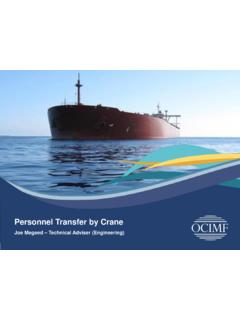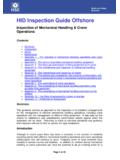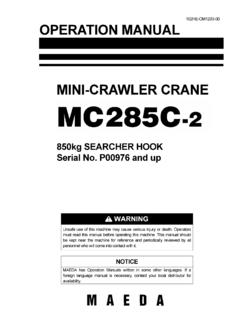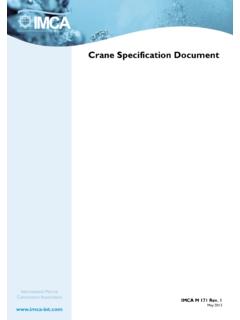Transcription of Specification for Offshore Pedestal Mounted Cranes
1 Specification for Offshore Pedestal Mounted Cranes API SPECIFICATION 2C. SIXTH EDITION, MARCH 2004. EFFECTIVE DATE: SEPTEMBER 2004. Specification for Offshore Pedestal Mounted Cranes Upstream Segment API SPECIFICATION 2C. SIXTH EDITION, MARCH 2004. EFFECTIVE DATE: SEPTEMBER 2004. SPECIAL NOTES. API publications necessarily address problems of a general nature. With respect to partic- ular circumstances, local, state, and federal laws and regulations should be reviewed. API is not undertaking to meet the duties of employers, manufacturers, or suppliers to warn and properly train and equip their employees, and others exposed, concerning health and safety risks and precautions, nor undertaking their obligations under local, state, or fed- eral laws. Information concerning safety and health risks and proper precautions with respect to par- ticular materials and conditions should be obtained from the employer, the manufacturer or supplier of that material, or the material safety data sheet.
2 Nothing contained in any API publication is to be construed as granting any right, by implication or otherwise, for the manufacture, sale, or use of any method, apparatus, or prod- uct covered by letters patent. Neither should anything contained in the publication be con- strued as insuring anyone against liability for infringement of letters patent. Generally, API standards are reviewed and revised, reaffirmed, or withdrawn at least every five years. Sometimes a one-time extension of up to two years will be added to this review cycle. This publication will no longer be in effect five years after its publication date as an operative API standard or, where an extension has been granted, upon republication. Status of the publication can be ascertained from the API Standards department telephone (202). 682-8000. A catalog of API publications, programs and services is published annually and updated biannually by API, and available through Global Engineering Documents, 15 Inv- erness Way East, M/S C303B, Englewood, CO 80112-5776.
3 This document was produced under API standardization procedures that ensure appropri- ate notification and participation in the developmental process and is designated as an API. standard. Questions concerning the interpretation of the content of this standard or com- ments and questions concerning the procedures under which this standard was developed should be directed in writing to the Director of the Standards department, American Petro- leum Institute, 1220 L Street, , Washington, 20005. Requests for permission to reproduce or translate all or any part of the material published herein should be addressed to the Director, Business Services. API standards are published to facilitate the broad availability of proven, sound engineer- ing and operating practices. These standards are not intended to obviate the need for apply- ing sound engineering judgment regarding when and where these standards should be utilized.
4 The formulation and publication of API standards is not intended in any way to inhibit anyone from using any other practices. Any manufacturer marking equipment or materials in conformance with the marking requirements of an API standard is solely responsible for complying with all the applicable requirements of that standard. API does not represent, warrant, or guarantee that such prod- ucts do in fact conform to the applicable API standard. All rights reserved. No part of this work may be reproduced, stored in a retrieval system, or transmitted by any means, electronic, mechanical, photocopying, recording, or otherwise, without prior written permission from the publisher. Contact the Publisher, API Publishing Services, 1220 L Street, , Washington, 20005. Copyright 2004 American Petroleum Institute FOREWORD. This specification is under the jurisdiction of the API Subcommittee on Standardization of Offshore Structures.
5 The purpose of this specification is to provide standards for Offshore Pedestal Mounted Cranes suitable for use in drilling and production operations. This standard shall become effective on the date printed on the cover but may be used vol- untarily from the date of distribution. This edition of API Spec 2C supercedes the Fifth Edition dated April 1995. The number and nature of changes in this edition from the previous edition are such that marking the changes between the two editions is impractical. API publications may be used by anyone desiring to do so. Every effort has been made by the Institute to assure the accuracy and reliability of the data contained in them; however, the Institute makes no representation, warranty, or guarantee in connection with this publication and hereby expressly disclaims any liability or responsibility for loss or damage resulting from its use or for the violation of any federal, state, or municipal regulation with which this publication may conflict.
6 Suggested revisions are invited and should be submitted to API, Standards department, 1220 L Street, NW, Washington, DC 20005. iii CONTENTS. Page 1 SCOPE .. 1. General .. 1. Safe Working Limits .. 1. Critical Components .. 2. Commentary.. 2. Record Retention .. 2. Manufacturer Supplied Documentation .. 2. 2 REFERENCES .. 3. Standards .. 3. Other References .. 4. 3 DEFINITIONS, ABBREVIATIONS, AND UNITS .. 4. Definitions .. 4. Abbreviations .. 8. Units .. 8. 4 crane RATINGS .. 8. General .. 8. Load Rating and Information Charts.. 10. In-service Loads.. 12. Out-of-service Loads .. 15. Wind, Ice, and Seismic Loads .. 15. Gross Overload Conditions .. 17. 5 ALLOWABLE STRESSES .. 17. General .. 17. Pedestal , King Post, and Platform Connection .. 18. Exceptions to the Use of the AISC Specification .. 18. Fatigue .. 18. Certification .. 18. 6 DESIGN AUTHENTICATION AND TESTING .. 18. Design Authentication.
7 18. Certification .. 19. Operational Tests .. 19. 7 CRITICAL RIGGING COMPONENTS .. 19. General .. 19. Wire Rope .. 19. Wire Rope End Terminations .. 20. Sheaves.. 21. Load Block Assemblies .. 21. 8 BOOM HOIST, LOAD HOIST, AND TELESCOPING BOOM MECHANISMS .. 22. Hoists .. 22. Boom Control.. 25. Telescoping Boom Mechanisms .. 25. v Page 9 SWING MECHANISM .. 25. Swing Mechanism .. 25. Swing-circle Assembly .. 26. 10 POWER PLANT .. 28. General .. 28. Exhaust Systems of Internal Combustion Prime Movers .. 28. Fuel Tanks .. 29. Hazardous Area Classifications .. 29. Isolation of Ignition Sources and Heated Surfaces .. 29. Diesel Air Intake Shut-off .. 29. 11 CONTROLS .. 29. General .. 29. Power Plant Controls .. 29. Engine Clutch.. 30. crane Controls Basic Lever Operating Arrangements.. 30. 12 CABS AND ENCLOSURES .. 31. General .. 31. Windows.. 31. Doors .. 31. Cab Access .. 31. Platforms and Walkways.
8 31. Rigging Access.. 31. Noise Level .. 31. 13 MISCELLANEOUS REQUIREMENTS AND EQUIPMENT.. 31. Boom Equipment .. 31. Guards for Moving Parts .. 33. Clutch and Brake Protection .. 33. Lubricating Points and Fluid Fills .. 33. Hydraulic and Pneumatic Line Protection .. 34. Use of Environmentally Sensitive Materials .. 34. Anti Two-block .. 34. Personnel Emergency Load Lowering .. 34. Miscellaneous Equipment .. 34. 14 MATERIAL REQUIREMENTS FOR STRUCTURAL COMPONENTS .. 34. Materials.. 34. Traceability.. 35. Fracture Toughness .. 35. Castings .. 35. Fasteners.. 36. Plate .. 36. 15 WELDING OF CRITICALLY STRESSED COMPONENTS .. 36. Standards .. 36. Welding Procedures .. 36. Welder Performance.. 36. Welding Properties.. 36. Page 16 NONDESTRUCTIVE EXAMINATION OF CRITICAL COMPONENTS .. 36. Nondestructive Examination Procedures .. 36. Nondestructive Examination Personnel Qualifications.. 36. Minimum Extent of Nondestructive Examination.
9 36. Examples of Workmanship Standards.. 37. 17 MARKING .. 37. APPENDIX A EXAMPLE LIST OF CRITICAL COMPONENTS .. 39. APPENDIX B COMMENTARY .. 41. APPENDIX C MINIMUM PURCHASER-DEFINED REQUIREMENTS .. 49. APPENDIX D API MONOGRAM MARKING .. 51. APPENDIX E EXAMPLE CALCULATIONS .. 53. Tables 1 Summary of Design Parameters .. 9. 2 Vertical Velocity for Dynamic Coefficient Calculations .. 15. 3 Onboard Lift Dynamic Coefficients (Cv for General Method) .. 16. 4 crane Base Inclinations and Accelerations.. 16. 5 Vertical Dynamic Accelerations to be Applied to crane Components .. 16. 6 Sheave Groove Radius .. 22. 7 Basic Four-lever crane Control Function.. 30. 8 Basic Two-lever crane Control Function (Option 1) .. 32. 9 Basic Two-lever crane Control Function (Option 2) .. 33. 10 Acceptable Criteria Based on ASTM Radiographic Standards .. 35. 11 Workmanship Standard Examples .. 37. General Method Vessel Information.
10 41. General Method Sample Design Value Calculations .. 42. Minimum Required Hook Speeds at the Supply Boat Deck vs. Significant Wave Height .. 43. Example Equivalent Fatigue Design Loads .. 44. Figures 1 crane Assembly Types .. 1. 2 crane Nomenclature .. 2. 3 Plots of Rated Loads for Various Operating Conditions .. 11. 4 Methods of Securing Dead End of Rope when Using Wedge Sockets .. 20. 5 Sheave Dimension.. 21. 6 Hoist Drum .. 24. 7 Basic Four-lever crane Control Diagram .. 30. 8 Basic Two-lever crane Control Diagram (Option 1) .. 32. 9 Basic Two-lever crane Control Diagram (Option 2) .. 33. API Monogram Nameplate .. 51. Specification for Offshore Pedestal Mounted Cranes 1 Scope construction and salvage operations within a harbor or shel- tered area or in very mild Offshore environmental conditions. GENERAL. This specification details the requirements for design, con- SAFE WORKING LIMITS.





